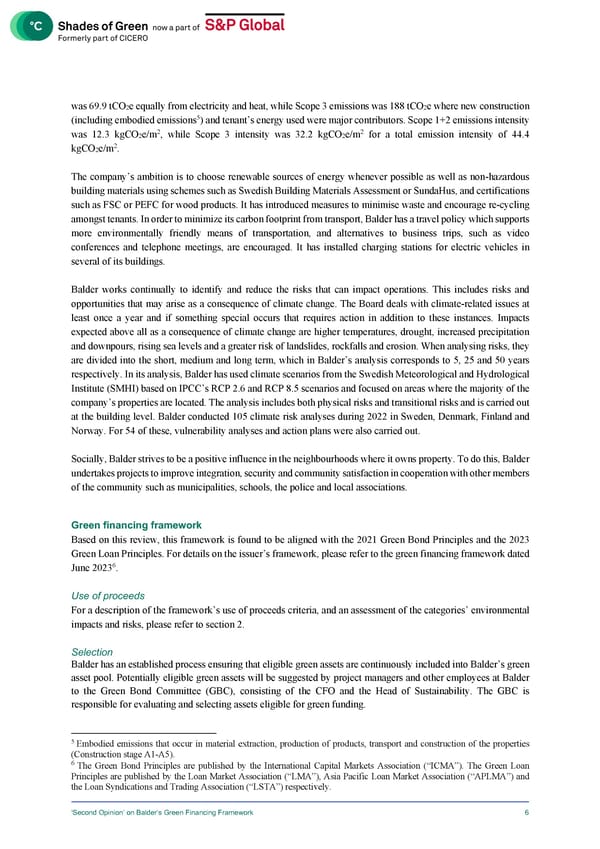‘Second Opinion’ on Balder ’s Green Financing Framework 6 was 69.9 tCO 2 e equally from electricity and heat, while Scope 3 emissions was 188 tCO 2 e where new construction (including embodied emissions 5 ) and tenant ’s energy used were major contributors. Scope 1+2 emi ssions intensity was 12.3 kg CO 2 e/m 2 , while Scope 3 intensity was 32.2 kgCO 2 e/m 2 for a total emission intensity of 44.4 kgCO 2 e/m 2 . The company’s ambition is to choose renewable sources of energy whenever possible as well as non - hazardous building materials using schemes such as Swedish Building Materials Assessment or SundaHus, and certifications such as FSC or PEFC for wood products. It has introduced measures to minimise waste and encourage re - cycling amongst tenants. In order to minimize its carbon footprint from transport, Balder has a travel policy which supports more environmentally friendly means of transportation, and alternati ves to business trips, such as video conferences and telephone meetings, are encouraged. It has installed charging stations for electric vehicles in several of its buildings. Balder works continually to identify and reduce the risks that can impact opera tions. This includes risks and opportunities that may arise as a consequence of climate change. The Board deals with climate - related issues at least once a year and if something special occurs that requires action in addition to these instances. I mpacts ex pected above all as a consequence of climate change are higher temperatures, drought, increased precipitation and downpours, rising sea levels and a greater risk of landslides, rockfalls and erosion. When analysing risks, they are divided into the short, m edium and long term, which in Balder’s analysis corresponds to 5, 25 and 50 years respectively. In its analysis, Balder has used climate scenarios from the Swedish Meteorological and Hydrological Institute (SMHI) based on IPCC’s RCP 2.6 and RCP 8.5 scenari os and focused on areas where the majority of the company’s properties are located. The analysis includes both physical risks and transitional risks and is carried out at the building level . Balder conducted 105 climate risk analyses during 2022 in Sweden, Denmark, Finland and Norway. For 54 of these, vulnerability analyses and action plans were also carried out. Socially, Balder strives to be a positive influence in the neighbourhoods where it owns property. To do this, Balder undertakes projects to impr ove integration, security and community satisfaction in cooperation with other members of the community such as municipalities, schools, the police and local associations. Green financing framework Based on this review, this framework is found to be aligned with the 2021 Green Bond Principles and the 2023 Green Loan Principles . For details on the issuer’s framework, please refer to the green financing framework dated June 2023 6 . Use of proceeds For a description of the framework’s use of proceeds criteria, and an assessment of the categories’ environmental impacts and risk s , please refer to section 2 . Selection Balder has an established process ensuring that eligible green assets are continuously included into Balder’s green asset pool. Potentially eligible green assets will be suggested by project managers and other employees at Balder to the Green Bond Committe e (GBC), consisting of the CFO and the Head of Sustainability. The GBC is responsible for evaluating and selecting assets eligible for g reen funding. 5 Embodied emissions that occur in material extraction, production of products, transport and construction of the properties (Construction stage A1 - A5). 6 The Green Bond Principles are published by the International Capital Markets Association (“ICMA”) . The Green Loan Principles are published by the Loan Market Association (“LMA ”), Asia Pacific Loan Market Association (“APLMA”) and the Loan Syndications and Trading Association (“LSTA”) respectively.
 Fastighets AB Balder Page 5 Page 7
Fastighets AB Balder Page 5 Page 7